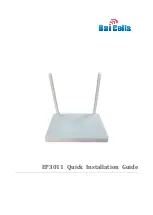
16
Description
TB9400/TN9275 Installation and Operation
© Tait International Limited May 2023
allowing integration with an SNMP-based network management
system.
■
An integrated wiring solution is provided for the system control bus and
DC power connections to each module in the subrack
■
Reciters (receiver/exciter modules) can be replaced without affecting
the operation of other reciters in the same subrack
■
Rugged construction with generous heatsinks and fan-forced cooling
for continuous operation from – 30° C to + 60° C (– 22° F to + 140° F)
1.3
Firmware Application Details
1.3.1
P25/AS-IP
The TB9400 is designed for operation as a transceiver in P25 trunked and
trunked simulcast (Phase 1 or Phase 2), P25 conventional networks and
analog conventional networks. It operates as a stand-alone base station, or
as part of a channel group, providing receiver voting and simulcast
transmission. All air interfaces and system types support simulcast
operation.
In a trunked simulcast network, the transmitters in the channel group are
synchronized and transmit simultaneously on the same frequency. Each
transmitter needs a highly accurate 1PPS pulse and an external frequency
reference, so that it can time transmissions with the required accuracy. Also
required is an NTP source that is derived from the same source as the 1PPS
signal. This will ensure a common timestamp in logs across all units in the
system. An external frequency reference, along with an NTP source and
1PPS signal derived from the same GPS source, are also essential for all
reciters for P25 Phase 2 operation.
Dispatch connection is via three distinct interfaces:
■
P25 standard DFSI connection (up to three connections simultaneously)
■
Analog line
■
Tait P25 Console Gateway, supporting conversion between P25 and
analog consoles with MDC1200 signaling
In an analog conventional network, the base station can operate as a
repeater with CTCSS or DCS subaudible signaling.
The base station can also operate as part of an analog conventional
simulcast network and is fully IP-connected. The base station also features
an internally integrated voter, and therefore requires no external voter.
The base station can be provided as a receive-only variant in systems that
need sites to enhance the receive coverage. The receiver module in a
receive-only base station is physically unable to transmit.
















































